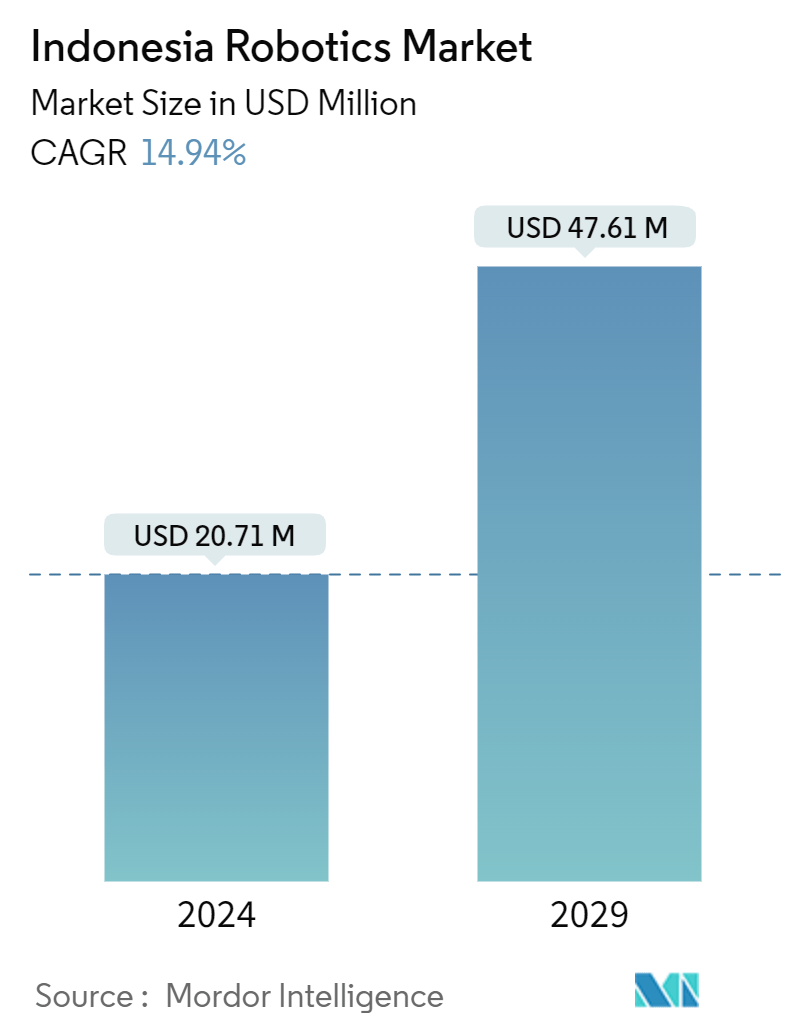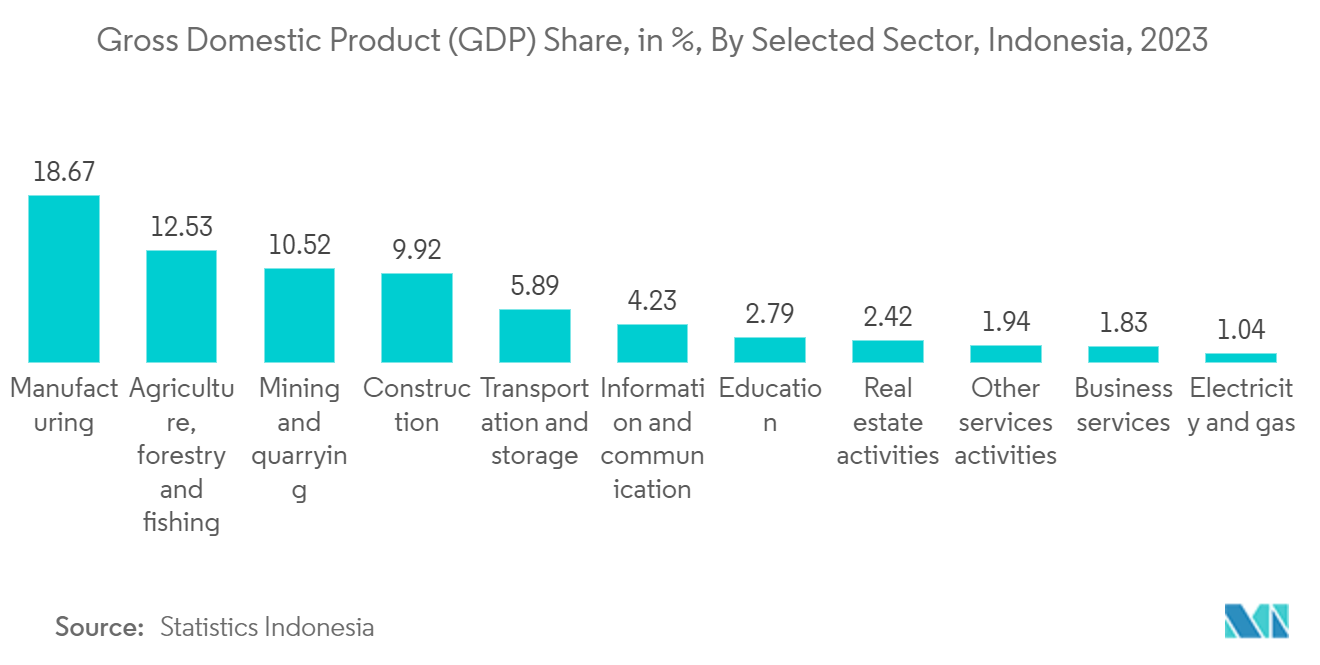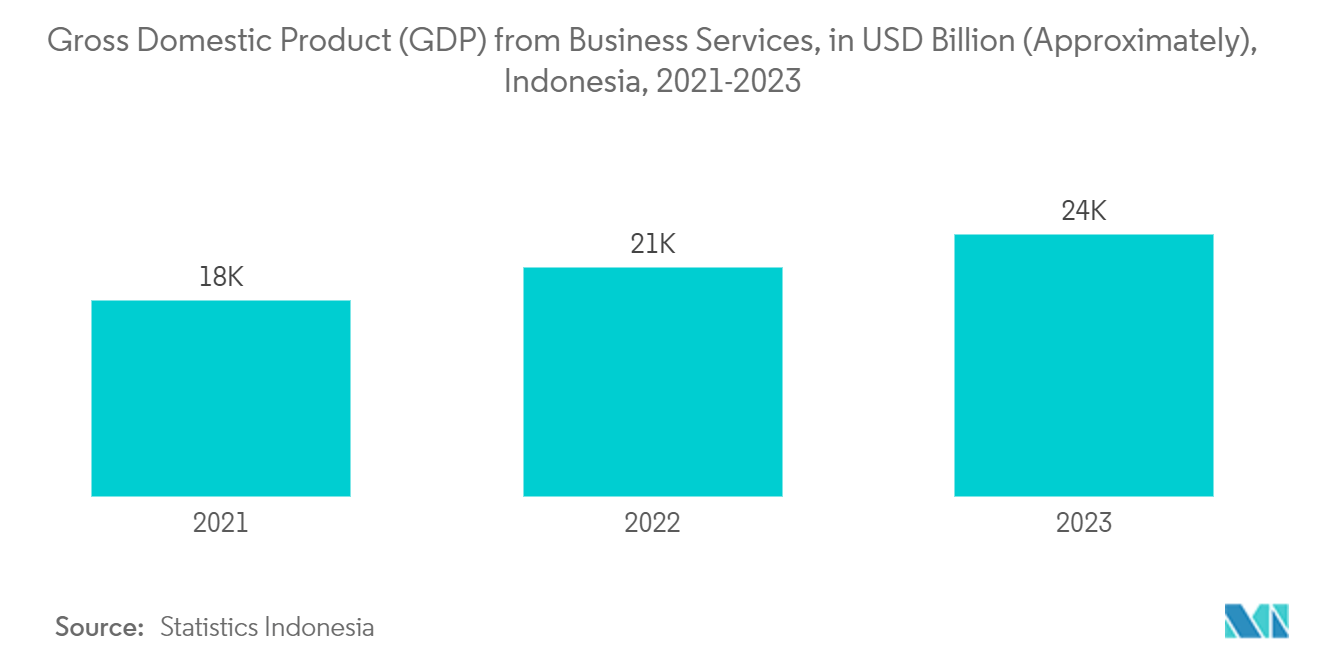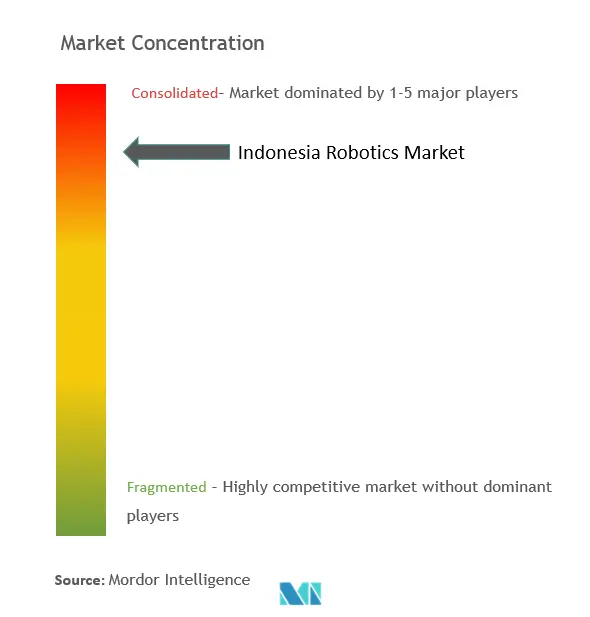Indonesia Robotics Market Size

| Study Period | 2019 - 2029 |
| Base Year For Estimation | 2023 |
| Market Size (2024) | USD 20.71 Million |
| Market Size (2029) | USD 47.61 Million |
| CAGR (2024 - 2029) | 14.94 % |
| Market Concentration | High |
Major Players
*Disclaimer: Major Players sorted in no particular order |
Indonesia Robotics Market Analysis
The Indonesia Robotics Market size is estimated at USD 20.71 million in 2024, and is expected to reach USD 47.61 million by 2029, growing at a CAGR of 14.94% during the forecast period (2024-2029).
Rapid technological advancements in automation, energy storage, engineering, machine learning, and artificial intelligence are critical market drivers. A significant factor fueling the adoption of robots is the prevalent skill shortage nationwide. Organizations are increasingly turning to robotic systems as they face the necessity of frequently training their workforce to keep pace with technological shifts.
- The Indonesian robotics market is undergoing a notable transformation. Once confined to industrial shop floors, robots are now expanding their roles. They are stepping into diverse fields, serving as personal assistants, aiding in surgeries, powering autonomous and delivery vehicles, donning exoskeletons, and even piloting crewless aerial vehicles.
- Service robots are gaining traction due to the advantages they offer, including superior speed, labor cost savings, heightened safety, and ensuring greater consistency and precision. In industrial automation, robots are pivotal, handling a spectrum of core operations across industries. Additionally, bolstered by economic growth, the electronics and automotive industries are surging. To meet the escalating demand, manufacturers are swiftly integrating robots to automate repetitive tasks.
- Moreover, Indonesia's growing population and expanding middle-income group have created a substantial market for consumer goods, which, in turn, has enhanced the demand for automation in manufacturing. For example, as of July 2023, according to the Census Bureau of the United States, Indonesia was the world's fourth most populous nation, with around 279 million people. Robotics is expected to become crucial in maintaining competitiveness and ensuring production scalability as businesses intend to meet rising consumer demands.
- Further, the government's increased recognition of the significance of technology and innovation in economic development is a potential market growth driver. Policies that support the automation of industries and research and development initiatives have created a supportive environment for the growth of the robotics industry.
- The trend of robotic system integration has grown significantly in the past few years in industries including electronics, automotive, and food processing. These robots are used in applications ranging from quality checking and packaging to welding and assembly. Robotics' versatility in handling complex and repetitive tasks makes them an attractive investment for businesses seeking to enhance productivity and maintain high-quality standards.
- However, challenges such as the need for a skilled workforce, concerns over job displacement, and initial investment costs are also part of Indonesia's journey in the robotics market. Overcoming these challenges demands a strategic approach, including investments in teaching and training programs to develop the necessary skills for working with and managing robotic systems.
- Indonesia's overall economic growth has been a significant driver of robotics adoption. Moreover, according to the Asian Development Outlook (ADO) of September 2023, Indonesia's GDP was predicted to expand by 5% in 2023. As businesses seek to enhance productivity and efficiency to keep up with demand, an expanding economy often results in more expenditures on automation technologies.
Indonesia Robotics Market Trends
Industrial Robots Expected to Witness a Significant Growth Rate
- Industrial robots are emerging as critical drivers of substantial growth in the rapidly evolving Indonesian robotics market. The industrial landscape in Indonesia is witnessing a surge in the adoption of robotic automation across various sectors, positioning end users as significant contributors to this transformative trend. The manufacturing industry, which produces heavy machinery, automobiles, and electronics, has been driving this technological shift and deploying industrial robots to improve operating efficiency.
- In the automotive sector, industrial robots are becoming integral to production processes, ranging from assembly lines to intricate welding tasks. This heightened integration streamlines manufacturing workflows and responds to the increasing demand for vehicles with precision, efficiency, and adherence to high-quality standards. As automotive manufacturers in Indonesia leverage the advantages of robotic automation, the end users in this sector are poised to play a pivotal role in driving the market's growth.
- Heavy machinery production represents another crucial sector where end-user influence is significant. Industrial robots are increasingly employed for welding, material handling, and intricate assembly tasks. Adopting robotic solutions in heavy machinery manufacturing accelerates production cycles and ensures the precision required in complex processes. As manufacturers in this sector recognize the transformative potential of industrial robots, end users are actively contributing to the burgeoning growth of the robotics market.
- According to Statistics Indonesia, Indonesia's manufacturing sector spearheaded the nation's economy, constituting about 18.67% of the GDP in 2023. The wholesale and retail trade sector followed closely, with agriculture securing the third spot. A growing manufacturing sector often demands higher efficiency, precision, and productivity, which are precisely the characteristics that industrial robots bring to production processes. As manufacturing industries, such as automotive, electronics, and heavy machinery, expand and enhance their operations, adopting industrial robots becomes integral to sustaining and further accelerating this growth.
- Further, the significant increase in end users' adoption of industrial robots aligns with Indonesia's broader goals of technical advancement and economic competitiveness. The government's initiatives to promote innovation and technological adoption further drive this growth. Industry 4.0, emphasizing digital transformation and smart manufacturing, is driving end users to invest in industrial robots for sustainable and efficient production practices.

Sumatra Region is Expected to Hold a Significant Share of the Market
- The Sumatra region, encompassing provinces on Sumatra Island, the Riau Islands, and the Bangka Belitung Islands, is a prime focus for companies engaged in extracting, processing, and transporting commodities. Sumatra is a significant hub for agricultural products, notably palm oil, rice, and rubber, boasting oil, gas, tin, bauxite, and coal. Its strategic positioning adjacent to the Malacca Strait, a vital shipping route between Indonesia and the Malay Peninsula, has heightened its appeal to exporters and the infrastructural entities that support them.
- In a move underscoring this, in June 2023, DP World unveiled plans to amplify the Belawan New Container Terminal's capacity to 1.4 million 20-foot equivalent units as part of a substantial USD 7.5 billion collaboration with Indonesia's sovereign wealth fund, INA, aimed at fortifying the nation's shipping and port industries.
- Manufacturing in developing and underdeveloped nations is witnessing a significant shift toward automation. While this evolution is reshaping the industry, there is also a notable trend of workers increasingly transitioning to the service sector. While contributing to job growth, this shift also exerts downward pressure on wages, leading to a scenario where pay stagnation is more prevalent than widespread unemployment, at least in the near to medium term. While the rise of digital technologies poses a perceived existential threat to manufacturing in developing nations, these concerns are often rooted in technical capabilities. Yet, the automation of jobs hinges not just on technical feasibility but also on economic and institutional factors, which can hold more weight in underdeveloped economies.
- The e-commerce industry's order fulfillment contributes significantly to the expanding use of logistics robots. Due to increased online consumers, merchants are compelled to adopt the automation process to execute repetitive activities utilizing robotic solutions to keep up with delivery schedules. Furthermore, effective digital automation network integration provides a real-time picture of activities. As a result, factories, transportation companies, and other organizations may examine the state of their operations in real-time. This function is crucial for the e-commerce industry because it focuses on meeting consumers' expectations on time. This contributes to the market's growth as well.
- Sanitation has been a growing challenge, particularly in densely populated places. Restaurants, hospitals, hotels, airports, and schools are just a few examples. As a result, the market is witnessing an increasing number of businesses and organizations opt for automated systems to disinfect workplaces and public places.
- There are multiple methods to sterilize space in hospitals, including UV disinfection. UV radiation ranging from 200 to 300 nm can neutralize microorganisms such as bacteria and viruses, disinfecting air and solid surfaces. Within 10 minutes, ultraviolet disinfection robots can kill 99.9% of all bacteria in a hospital room. While the room must be vacant during disinfection, the UV rays have no detrimental impact. These robots do not replace cleaning workers, who must remove 'hard' stains like blood and other substances.
- Moreover, according to Statistics Indonesia, preliminary figures in 2023 showed that the gross domestic product (GDP) from business services in Indonesia amounted to approximately USD 24,000 billion. The service sector's substantial contribution presents a considerable market for service robots to enhance efficiency and innovation in various service-oriented industries. This would propel market players to develop new service robots to capture market share.

Indonesia Robotics Industry Overview
The Indonesian robotics market is expected to be consolidated in nature, owing to the presence of only a few firms holding significant market shares. Some of the key players include ABB, Fanuc, Omron Adept, and Kawasaki. Key players in this market are introducing new product innovations and engaging in partnerships and collaborations to gain competitive advantages.
In November 2023, Yaskawa Electric Corporation announced the launch of a new industrial automation platform by accelerating the development of i3-Mechatronics, a solution concept based on using digital data at factories and other facilities using mechatronics products like servo drives and industrial robots. The launch of the MOTOMAN NEXT series (5 models with payload capacities of 4 kg, 7 kg, 10 kg, 20 kg, and 35 kg) is one of the key releases. This robot is the first in the industrial robot segment to have the ability to adapt to its surroundings and create judgments autonomously.
In September 2023, Sari Teknologi, an Indonesian robotics firm, and Hills Robotics, a Korean distributor, inked an MOU to bolster their presence in Indonesia. Acting as Hills Robotics' sales arm, Sari Teknologi will champion the suite of robots – from warehouse (Lo-robot) and guide (Hey-bot) to museum docent (Hi-bot) and medical service (Meca-bot) robots – with a keen focus on the Indonesian market. Notably, with Sari Teknologi's backing, Hills Robotics' medical care robots are set to be deployed at the University Hospital of Gunadarma University in Indonesia.
Indonesia Robotics Market Leaders
-
Omron Corporation
-
ABB Ltd
-
FANUC CORPORATION
-
Kawasaki Heavy Industries, Ltd.
-
Mitsubishi Electric Corporation
*Disclaimer: Major Players sorted in no particular order

Indonesia Robotics Market News
- February 2024: The Robotic Telesurgery Center announced that it would be expanding to bridge the 3,500-kilometer gap between Indonesia's western and eastern islands. Recently, the Haji Adam Malik Central General Hospital in North Sumatra (west Indonesia) and the Dr. Wahidin Sudirohusodo Makassar in Sulawesi (east Indonesia) formalized their collaboration with a memorandum of understanding. The application of robotic telesurgery is anticipated in digestive, urology, and gynecology procedures shortly. Building on the success of its pilot in May 2023, which involved the Dr. Hasan Sadikin Hospital in Bandung and the Dr. Sardjito Hospital in Yogyakarta, the telesurgery project is now expanding. Notably, Sina Robotics supplied its robotic surgical system to these pilot sites 500 kilometers apart.
- November 2023: Libiao Robotics, a Chinese mobile robotics expert, partnered with Pos Indonesia (Pos Ind), a state-owned courier services, logistics, and financial transactions enterprise, to offer a customized robotic sorting system. The company has deployed orange robots instead of the typical yellow ones to help Pos Indonesia increase the efficiency of its site operations and order fulfillment capacity. Libiao Robotics' automated sorting product line includes the development, production, and use of autonomous guided vehicles (AGVs).
Indonesia Robotics Market Report - Table of Contents
1. INTRODUCTION
1.1 Study Assumptions and Market Definition
1.2 Scope of the Study
2. RESEARCH METHODOLOGY
3. EXECUTIVE SUMMARY
4. MARKET INSIGHTS
4.1 Market Overview
4.2 Impact of Macroeconomic Trends
4.3 Ecosystem Analysis
5. MARKET DYNAMICS
5.1 Market Drivers
5.1.1 Industrial Automation and Cost Efficiency
5.1.2 Increasing Emphasis on Safety
5.2 Market Restraints
5.2.1 High Initial Costs
5.3 Key Use Cases
5.4 Volume of Industrial and Service Robots
6. MARKET SEGMENTATION
6.1 By Type
6.1.1 Industrial Robots
6.1.1.1 Automotive
6.1.1.2 Food & Beverage
6.1.1.3 Electronics
6.1.1.4 Other End Users of Industrial Robots
6.1.2 Service Robots
6.1.2.1 Logistics
6.1.2.2 Military and Defense
6.1.2.3 Medical and Healthcare
6.1.2.4 Other End Users of Service Robots
6.2 By Region
6.2.1 Java
6.2.2 Sumatra
6.2.3 Kalimantan
6.2.4 Other Regions (Sulawesi, Papua & Muluku, and Bali & Nusa Tenggara)
7. COMPETITIVE LANDSCAPE
7.1 Company Profiles
7.1.1 Omron Corporation
7.1.2 FANUC CORPORATION
7.1.3 ABB Ltd
7.1.4 Kawasaki Heavy Industries Ltd
7.1.5 Mitsubishi Electric Corporation
7.1.6 PT Yaskawa Electric Indonesia
7.1.7 PT Epson Indonesia
7.1.8 Shibaura Machine Co. Ltd
7.1.9 Staubli International AG
7.1.10 DENSO Corporation
- *List Not Exhaustive
8. MARKET OPPORTUNITIES
9. FUTURE OF THE MARKET
Indonesia Robotics Industry Segmentation
Robotics is a multidisciplinary branch of engineering and science that involves designing, constructing, operating, and using robots. A robot is a programmable machine that can automatically carry out a series of complex actions with a certain degree of autonomy.
The Indonesian robotics market is segmented by type and region. By type, the market is segmented into industrial robots, which is further segmented into automotive, food & beverage, electronics, and other end users of industrial robots, and service robots, further segmented into logistics, military and defense, medical and healthcare, and other end users of service robots. By region, the market is segmented into Java, Sumatra, Kalimantan, and other regions (Sulawesi, Papua & Muluku, and Bali & Nusa Tenggara).
The market sizes and forecasts are provided in terms of value (USD) for all the above segments.
| By Type | ||||||
| ||||||
|
| By Region | |
| Java | |
| Sumatra | |
| Kalimantan | |
| Other Regions (Sulawesi, Papua & Muluku, and Bali & Nusa Tenggara) |
Indonesia Robotics Market Research FAQs
How big is the Indonesia Robotics Market?
The Indonesia Robotics Market size is expected to reach USD 20.71 million in 2024 and grow at a CAGR of 14.94% to reach USD 47.61 million by 2029.
What is the current Indonesia Robotics Market size?
In 2024, the Indonesia Robotics Market size is expected to reach USD 20.71 million.
Who are the key players in Indonesia Robotics Market?
Omron Corporation, ABB Ltd, FANUC CORPORATION, Kawasaki Heavy Industries, Ltd. and Mitsubishi Electric Corporation are the major companies operating in the Indonesia Robotics Market.
What years does this Indonesia Robotics Market cover, and what was the market size in 2023?
In 2023, the Indonesia Robotics Market size was estimated at USD 17.62 million. The report covers the Indonesia Robotics Market historical market size for years: 2019, 2020, 2021, 2022 and 2023. The report also forecasts the Indonesia Robotics Market size for years: 2024, 2025, 2026, 2027, 2028 and 2029.
Indonesia Robotics Industry Report
Statistics for the 2024 Indonesia Robotics market share, size and revenue growth rate, created by Mordor Intelligence™ Industry Reports. Indonesia Robotics analysis includes a market forecast outlook for 2024 to 2029 and historical overview. Get a sample of this industry analysis as a free report PDF download.

